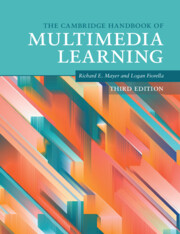Book contents
- The Cambridge Handbook of Multimedia Learning
- The Cambridge Handbook of Multimedia Learning
- Copyright page
- Contents
- Figures
- Tables
- Contributors
- Preface
- Acknowledgments
- Part I Background
- Part II Theoretical Foundations
- Part III Basic Principles of Multimedia Learning
- Part IV Principles for Reducing Extraneous Processing in Multimedia Learning
- Part V Principles for Managing Essential Processing in Multimedia Learning
- 19 Principles for Managing Essential Processing in Multimedia Learning
- 20 The Modality Principle in Multimedia Learning
- 21 The Transient Information Principle in Multimedia Learning
- Part VI Principles Based on Social and Affective Features of Multimedia Learning
- Part VII Principles Based on Generative Activity in Multimedia Learning
- Part VIII Multimedia Learning with Media
- Author Index
- Subject Index
- References
21 - The Transient Information Principle in Multimedia Learning
from Part V - Principles for Managing Essential Processing in Multimedia Learning
Published online by Cambridge University Press: 19 November 2021
- The Cambridge Handbook of Multimedia Learning
- The Cambridge Handbook of Multimedia Learning
- Copyright page
- Contents
- Figures
- Tables
- Contributors
- Preface
- Acknowledgments
- Part I Background
- Part II Theoretical Foundations
- Part III Basic Principles of Multimedia Learning
- Part IV Principles for Reducing Extraneous Processing in Multimedia Learning
- Part V Principles for Managing Essential Processing in Multimedia Learning
- 19 Principles for Managing Essential Processing in Multimedia Learning
- 20 The Modality Principle in Multimedia Learning
- 21 The Transient Information Principle in Multimedia Learning
- Part VI Principles Based on Social and Affective Features of Multimedia Learning
- Part VII Principles Based on Generative Activity in Multimedia Learning
- Part VIII Multimedia Learning with Media
- Author Index
- Subject Index
- References
Summary
Instructional information can be categorised as being either transient or permanent. Spoken information or videos provide examples of transient information, while written information or static graphics provide examples of permanent information. The major characteristic of transient information is that current information, once presented, disappears to be replaced by new information, with the old information difficult to access. Permanent information, once presented, remains available and accessible for the duration of the instructional episode. The transient information effect or principle can be demonstrated when the same information is presented in either transient form such as speech or permanent form such as identical, written text. The effect occurs when learning is facilitated by the permanent version of the information. Cognitive load theory can be used to explain such results.
Keywords
- Type
- Chapter
- Information
- The Cambridge Handbook of Multimedia Learning , pp. 268 - 274Publisher: Cambridge University PressPrint publication year: 2021
References
- 2
- Cited by



